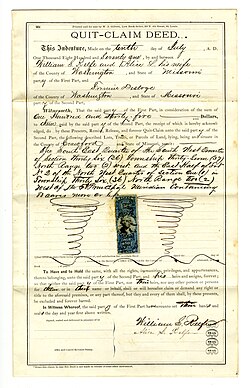A Quitclaim deed is a type of deed that transfers property without any warranty or guarantee.
Research your ancestors on MyHeritage
History of quitclaim deedsHistory of quitclaim deeds

The definition of a quitclaim, “to release a claim to or convey by a quitclaim deed” dates back to the 14th century in England,[1] in order to provide a straightforward way for a tenant or other person in actual possession of land to acquire additional rights in it from another individual.[2]
Use of quitclaim deedsUse of quitclaim deeds
Typically, when a person is selling land, they ensure that they own the property. In some cases, this type of warranty is not necessary. A quitclaim deed allows a grantor to sell or gift land without a warranty. As such, quitclaims are a quick way to transfer property from one person to another. This type of deed is often used in cases where the warranty is unnecessary, such as in divorces where one spouse is signing over their rights to a property to the other or when transferring property to another family member like a child, for example. It is also used to correct a minor problem with the title, such as a misspelling.[3]
As mentioned above, the quitclaim does not come with it any warranties or guaranties, including that the grantor has the right to deed the property. It is up to the grantee to check if the grantor owns the property and if there are any legal encumbrances that would prohibit the grantee from taking title of the property.[4]
See alsoSee also
Explore more about quitclaim deedsExplore more about quitclaim deeds
- Finding Kentucky Land: Grants, Deeds and the Missing Pieces webinar at Legacy Family Tree Webinars
- Quit Claim Deeds and Deed Releases. GenealogyBlog
- 6 February 1991- GENEALOGY WITH DEEDS, MORTGAGES AND PROBATE RECORDS. Jonesborough Genealogical Society
References
- ↑ Quitclaim. Merriam-Webster Dictionary
- ↑ Pollock, Frederick; Maitland, Frederic William (1898). The History of English Law Before the Time of Edward I. Vol. II (2nd ed.). Indianapolis: Republished 2010 by Liberty Fund. pp. 94–95. ISBN 978-1-61487-849-0. OCLC 820841850
- ↑ Top 5 Facts about Quitclaim deeds. Investopedia
- ↑ Barron's Law Dictionary, pp. 381-382 (2d ed. 1984)

